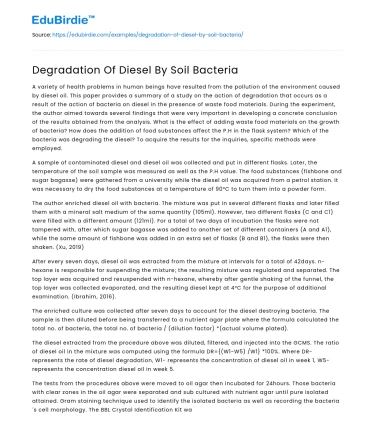A variety of health problems in human beings have resulted from the pollution of the environment caused by diesel oil. This paper provides a summary of a study on the action of degradation that occurs as a result of the action of bacteria on diesel in the presence of waste food materials. During the experiment, the author aimed towards several findings that were very important in developing a concrete conclusion of the results obtained from the analysis. What is the effect of adding waste food materials on the growth of bacteria? How does the addition of food substances affect the P.H in the flask system? Which of the bacteria was degrading the diesel? To acquire the results for the inquiries, specific methods were employed.
A sample of contaminated diesel and diesel oil was collected and put in different flasks. Later, the temperature of the soil sample was measured as well as the P.H value. The food substances (fishbone and sugar bagasse) were gathered from a university while the diesel oil was acquired from a petrol station. It was necessary to dry the food substances at a temperature of 90°C to turn them into a powder form.
Save your time!
We can take care of your essay
- Proper editing and formatting
- Free revision, title page, and bibliography
- Flexible prices and money-back guarantee
The author enriched diesel oil with bacteria. The mixture was put in several different flasks and later filled them with a mineral salt medium of the same quantity (105ml). However, two different flasks (C and C1) were filled with a different amount (121ml). For a total of two days of incubation the flasks were not tampered with, after which sugar bagasse was added to another set of different containers (A and A1), while the same amount of fishbone was added in an extra set of flasks (B and B1), the flasks were then shaken. (Xu, 2019)
After every seven days, diesel oil was extracted from the mixture at intervals for a total of 42days. n-hexane is responsible for suspending the mixture; the resulting mixture was regulated and separated. The top layer was acquired and resuspended with n-hexane, whereby after gentle shaking of the funnel, the top layer was collected evaporated, and the resulting diesel kept at 4°C for the purpose of additional examination. (Ibrahim, 2016).
The enriched culture was collected after seven days to account for the diesel destroying bacteria. The sample is then diluted before being transferred to a nutrient agar plate where the formula calculated the total no. of bacteria, the total no. of bacteria / (dilution factor) *(actual volume plated).
The diesel extracted from the procedure above was diluted, filtered, and injected into the GCMS. The ratio of diesel oil in the mixture was computed using the formula DR={(W1-W5) /W1} *100%. Where DR-represents the rate of diesel degradation, W1- represents the concentration of diesel oil in week 1, W5-represents the concentration diesel oil in week 5.
The tests from the procedures above were moved to oil agar then incubated for 24hours. Those bacteria with clear zones in the oil agar were separated and sub cultured with nutrient agar until pure isolated attained. Gram staining technique used to identify the isolated bacteria as well as recording the bacteria´s cell morphology. The BBL Crystal Identification Kit was used to ascertain the species of the bacteria. (Ekanem and Ogunjobi, 2017).
This figure indicates the bacteria´s growth curve from the bacteria beginning with lag phase, followed by log phase, later, the stationary phase, and lastly, the decline phase. The bacteria strains to adapt to the new environment during weeks 1 and 2 of the incubation. The growth rate of the bacteria increases in week three after it has adapted to the new environment but decreases at week four and week five since the nutrients have reduced, and a lot of toxic materials have accumulated. However, this does not happen to the bacteria in the flask containing sugar bagasse since the sugar provides additional nutrients to the bacteria. Thus it is evident that food substances contribute to the degradation of diesel oil by delivering nutrients to the bacteria. (Nimrat, et al, 2019).
Conclusion
The authors observed that adding food to the flask with the degradation bacteria increased the prolonged life of the bacteria; thus, more diesel was degraded. Additionally, a low P.H was observed in containers with sugarcane bagasse and those with fishbone, while those without showed no considerable changes in the incubation phase. Concerning the results of the experiment, the author concludes that the addition of food substances increased bacteria´s growth rate, and increased reduction of diesel is correct since the food substance provided nutrients for the bacteria, thus ensuring the continuity of the degradation process.
References
- Ekanem, J. O., & Ogunjobi, A. A. (2017). Hydrocarbon degradation potentials of bacteria isolated from spent lubricating oil contaminated soil. Journal of Applied Sciences and Environmental Management, 21(5), 973-979.
- Ibrahim, H. M. (2016). Biodegradation of used engine oil by novel strains of Ochrobactrum anthropi HM-1 and Citrobacter freundii HM-2 isolated from oil-contaminated soil. 3 Biotech, 6(2), 226.
- Nimrat, S., Lookchan, S., Boonthai, T., & Vuthiphandchai, V. (2019). Bioremediation of petroleum contaminated soils by lipopeptide producing Bacillus subtilis SE1.
- Xu, J., Zhang, Q., Li, D., Du, J., Wang, C., & Qin, J. (2019). Rapid degradation of long-chain crude oil in soil by indigenous bacteria using fermented food waste supernatant. Waste management, 85, 361-373.






 Stuck on your essay?
Stuck on your essay?

